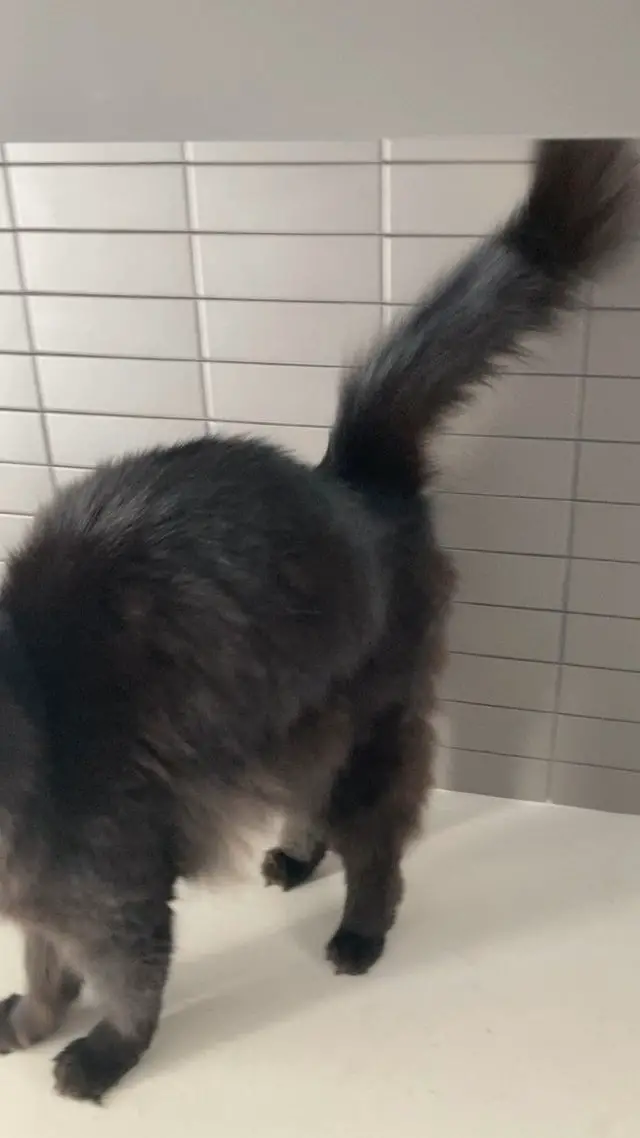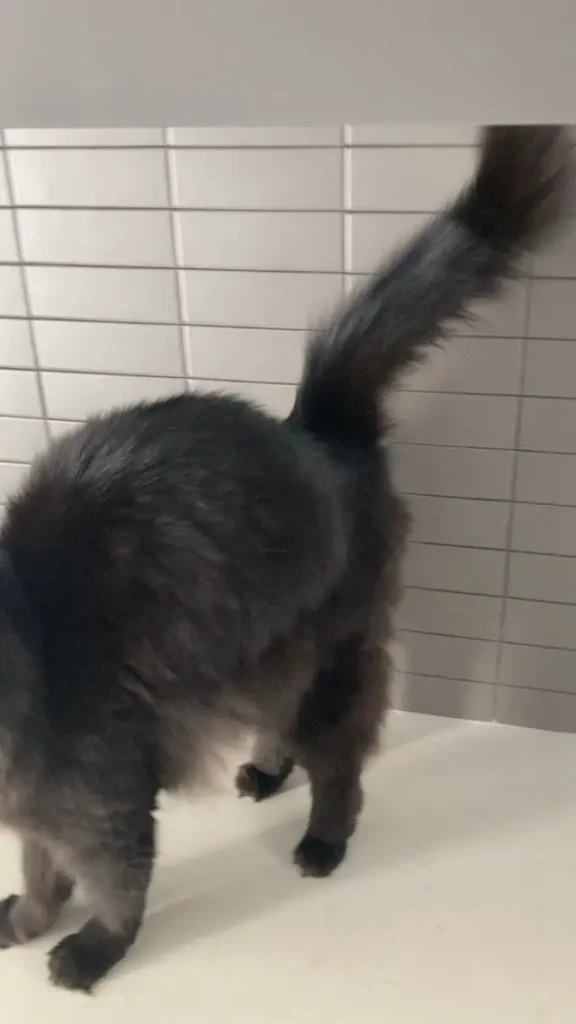Cats are fascinating creatures, mysterious and enigmatic in their movements and behavior. One of the most intriguing things about them is the way they use their tails. Although we often think of tails as simply a means of balance or communication, cats have a unique way of shaking their tails that can be both mesmerizing and a bit intimidating. So why do cats shake their tails like a rattlesnake? Let’s find out.
If you’re a cat owner or just love observing feline behavior, you may have witnessed your furry friend shaking their tail in a quick, back-and-forth motion. This is often accompanied by a tense body posture, dilated pupils, and even a growl or hiss. While it may look like aggressive behavior, there’s actually a lot more going on beneath the surface. Understanding why cats shake their tails like a rattlesnake can help us better communicate with these fascinating creatures and appreciate their unique personalities.
Cats shake their tail like a rattlesnake as a warning sign to potential predators or as a sign of aggression. They do this to intimidate their prey or to show their discomfort in a situation. This behavior is often accompanied by other warning signs such as hissing, growling, or arching their back.

Why Do Cats Shake Their Tail Like a Rattlesnake?
Cats are fascinating creatures with unique behaviors that often leave us puzzled. One of these behaviors is tail shaking, which resembles the rattlesnake’s rattle. If you’ve ever noticed your cat shaking its tail like a rattlesnake, you might be wondering what’s going on. In this article, we’ll explore the reasons behind this behavior and what it means.
1. Communication
Cats use their tails to communicate with us and other cats. Tail shaking is one of the ways they convey their message. When a cat is feeling agitated or threatened, it will shake its tail as a warning sign. The rapid movement of the tail is a clear signal that the cat is not happy and wants to be left alone.
On the other hand, when a cat is happy and content, it will often hold its tail upright and still. This is a sign that the cat is relaxed and comfortable. Understanding your cat’s tail language can help you communicate better with your furry friend.
2. Hunting Instincts
Cats are natural hunters, and their instincts drive them to stalk and catch prey. When a cat sees prey, it will often shake its tail as it prepares to pounce. This behavior is a sign of excitement and anticipation. It’s a way for the cat to prepare its body for the quick movements required to catch prey.
In addition to shaking its tail, a cat might also crouch low to the ground and wiggle its hindquarters before pouncing. These behaviors are all part of the cat’s hunting instinct and can be traced back to their wild ancestors.
3. Playful Mood
Cats are playful creatures that love to have fun. When a cat is in a playful mood, it might shake its tail as a way of expressing its excitement. This behavior is often accompanied by other playful behaviors, such as chasing toys or pouncing on its owners.
If you notice your cat shaking its tail while playing, it’s a good sign that your furry friend is happy and enjoying itself. You can encourage your cat’s playful behavior by providing plenty of toys and playtime.
4. Fear and Anxiety
While tail shaking can be a sign of excitement, it can also be a sign of fear and anxiety. When a cat is feeling scared or threatened, it might shake its tail as a way of expressing its distress. This behavior is often accompanied by other signs of anxiety, such as hiding, hissing, or growling.
If you notice your cat shaking its tail in a fearful or anxious way, it’s important to identify the cause of its distress. It could be a loud noise, a new visitor, or a change in its environment. Once you identify the cause, you can take steps to reduce your cat’s anxiety and help it feel more comfortable.
5. Aggression
In some cases, tail shaking can be a sign of aggression. When a cat is feeling aggressive, it might shake its tail as a warning sign to its prey or opponent. This behavior is often accompanied by other signs of aggression, such as growling, hissing, and showing its teeth.
If you notice your cat shaking its tail in an aggressive way, it’s important to address the behavior immediately. You should never encourage aggressive behavior in your cat, as it can lead to dangerous situations for both you and your furry friend.
6. Medical Issues
In rare cases, tail shaking can be a sign of an underlying medical issue. If your cat is shaking its tail excessively or in an unusual way, it could be a sign of pain or discomfort. Other signs of medical issues might include lethargy, loss of appetite, or vomiting.
If you suspect that your cat’s tail shaking is due to a medical issue, it’s important to consult with your veterinarian. They can perform a thorough examination and recommend the appropriate treatment.
7. Benefits of Understanding Your Cat’s Tail Language
Understanding your cat’s tail language can help you communicate better with your furry friend. By recognizing the signs of agitation, excitement, fear, and other emotions, you can respond appropriately and help your cat feel more comfortable and secure.
Moreover, understanding your cat’s tail language can also help you prevent dangerous situations. For instance, if you notice your cat shaking its tail in an aggressive way, you can take steps to separate it from other animals or people and prevent any harm.
8. Tail Shaking Vs. Tail Wagging
It’s important to note that tail shaking is different from tail wagging, which is a behavior commonly associated with dogs. While dogs wag their tails to express happiness and excitement, cats shake their tails for different reasons.
Tail shaking is often a sign of agitation, aggression, or fear, while tail wagging is a sign of happiness and contentment. By understanding the difference between the two, you can better interpret your cat’s behavior and respond accordingly.
9. Conclusion
In conclusion, tail shaking is a common behavior among cats that can mean different things depending on the context. Understanding your cat’s tail language can help you communicate better with your furry friend and prevent dangerous situations.
If you notice your cat shaking its tail excessively or in an unusual way, it’s important to identify the cause and take appropriate action. Whether it’s providing more playtime, reducing anxiety, or seeking medical attention, addressing the behavior can help your cat feel happier and healthier.
10. References
– https://www.thesprucepets.com/cat-tail-language-554180
– https://www.petmd.com/cat/behavior/cat-tail-talk-what-your-cats-tail-says-about-their-mood
– https://www.hillspet.com/cat-care/behavior-appearance/cat-tail-language
– https://www.thesprucepets.com/cat-hunting-instincts-554260
Frequently Asked Questions
What does it mean when a cat shakes its tail?
When a cat shakes its tail, it can be a sign of various emotions such as excitement, fear, or aggression. However, when a cat shakes its tail like a rattlesnake, it can be a sign of extreme agitation and anger.
This behavior is often seen in cats when they are feeling threatened or cornered. They may also shake their tail when they are about to pounce on prey, mimicking the movement of a rattlesnake’s tail to intimidate their prey.
Is tail shaking a normal behavior in cats?
Yes, tail shaking is a normal behavior in cats. They use their tails to communicate with their owners and other animals. A cat’s tail can convey various emotions such as happiness, fear, or anger. However, tail shaking like a rattlesnake is not a common behavior and should be taken seriously.
If you notice your cat shaking its tail in this manner, it may be best to give them some space and avoid any sudden movements that could further agitate them.
What are some other signs of an agitated cat?
Aside from tail shaking like a rattlesnake, there are other signs of an agitated cat that you should be aware of. These include hissing, growling, flattened ears, and an arched back. Your cat may also become more vocal than usual and may even swat at you if you try to approach them.
If you notice any of these signs, it’s best to give your cat some space and avoid any sudden movements that could further agitate them. It’s also important to try and identify the cause of their agitation so that you can avoid similar situations in the future.
How can you calm an agitated cat?
If your cat is agitated, it’s important to give them some space and avoid any sudden movements that could further agitate them. You can also try offering them some treats or toys to distract them from whatever is causing their agitation.
If your cat is extremely agitated and you feel like you can’t safely approach them, it may be best to seek the help of a professional animal behaviorist or veterinarian.
When should you be concerned about your cat’s behavior?
If your cat’s behavior is significantly different than their usual behavior, it’s important to pay attention and potentially seek the help of a veterinarian. This could be a sign of an underlying medical condition or an issue with their environment.
If your cat is consistently exhibiting aggressive behavior, it’s important to seek the help of a professional animal behaviorist to address the issue before it escalates further.
Cat’s Tail Meaning: What Your Cat’s Tail Says About Her Mood | Chewy
In conclusion, the tail-shaking behavior of cats is not only interesting but also essential in feline communication. It is a common misconception that this behavior is only associated with aggression or hunting. However, cats shake their tail for various reasons, including excitement, fear, or even happiness.
It is crucial to understand the reasons behind this behavior to ensure that your furry friend is happy and comfortable. Always observe your cat’s body language to determine their mood and adjust your interactions accordingly.
Next time you witness your cat shaking its tail like a rattlesnake, take a moment to observe their behavior and understand what they might be trying to communicate. By doing so, you will strengthen the bond between you and your feline companion and ensure a healthy and happy relationship.


